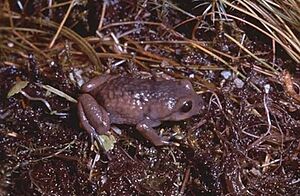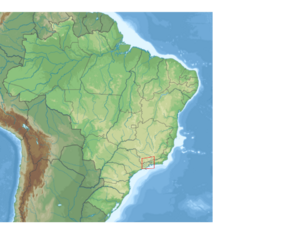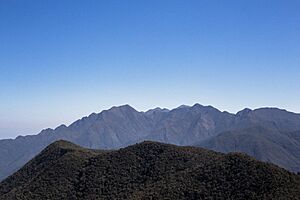Itatiaia highland frog facts for kids
Quick facts for kids Itatiaia highland frog |
|
|---|---|
 |
|
| Conservation status | |
| Scientific classification |
The Itatiaia highland frog, also known as Holoaden bradei, is a special type of frog. It belongs to the family Strabomantidae. This frog is found only in the Itatiaia Mountains in south-eastern Brazil. This means it is endemic to that area.
It lives in a small region, about 10 square kilometers (4 square miles). This area is very high up, between 2,400 and 2,600 meters (7,900 to 8,500 feet) above sea level. The frogs like to live among stones, dead leaves (mulch), and plants called bromeliads. They lay their eggs in these places. Young frogs hatch directly from the eggs, looking like tiny adults. Sadly, the Itatiaia highland frog might already be extinct in the wild. It has not been seen for many decades.
Contents
What Does the Itatiaia Highland Frog Look Like?
The Itatiaia highland frog is a small frog. Its skin is an olive-brown color. It has dark, uneven patches all over its body. The frog's belly is a creamy white color. The tips of its fingers are a bright yellow.
This frog has a large, wide head. Its body is oval-shaped, and its snout is rounded. It has short legs and big eyes that face forward. The pupils of its eyes are shaped like diamonds. Female frogs are a bit bigger than male frogs. Their snouts can be up to 3.7 centimeters (1.5 inches) long.
Where Do Itatiaia Highland Frogs Live?
Itatiaia highland frogs live on land. They are often found under leaves, mulch, and stones. They prefer open grassy areas or thin forests. These frogs also like to live in burrows or other shady spots. They can be found in shrublands, especially where it is moist.
As their name suggests, they live in the highlands of the Itatiaia Mountains. This area is in Brazil, across the states of Rio de Janeiro, Sâo Paulo, and Minas Gerais. They live at high elevations, from about 2,100 to 2,600 meters (6,900 to 8,500 feet) above sea level. People used to see them often until the 1970s. The last time one was seen was in 1976. Because of this, scientists believe they are most likely extinct.
The Calls of the Itatiaia Highland Frog
Scientists study animal calls to learn more about different species. A special recording from 1964 shows the last known sounds of this frog. This recording was made by Werner C. Bokerman. It contains 11 calls from the frog.
These calls are thought to be "distress calls." This means the frog made them when it was in danger or being held. Scientists noticed that the calls did not sound very similar to each other. However, the sound always got quieter at the end of the call. This might happen when the frog closes its mouth. Some calls started with a quick rise in sound, then a fast drop. Others started quietly and then dropped quickly.
Why Are Itatiaia Highland Frogs in Danger?
The Itatiaia highland frog is listed as critically endangered by the IUCN Red List. This means it is at a very high risk of becoming extinct. Many things might have caused their possible disappearance.
One big problem is the loss of their habitat. This happens when forests are cut down (deforestation). It also happens when land is used for farming or building cities. These changes break up the frog's living areas. Other threats include strong frosts, pollution, and climate change. Wildfires are also a danger.
In the late 1980s, many frog populations started to drop. This was linked to a disease caused by a type of fungus called chytrid fungus. Deforestation is made worse by cattle ranching. About three-quarters of the Amazon rainforest clearing is for cattle farms. Losing forests also harms many other plants and animals. It also adds to global warming.
Frogs and other amphibians are more sensitive to these threats than mammals or birds. The Itatiaia highland frog is on several "red lists" in Brazil. Brazil has many different kinds of amphibians and other animals. The country has tried to protect nature by making conservation areas. However, it is not known if these efforts are helping the Itatiaia highland frog, since it has not been seen in decades.
Life Cycle and Reproduction
Scientists do not know much about how Itatiaia highland frogs reproduce. However, they believe these frogs use "direct development." This means the young frogs do not go through a tadpole stage. Instead, they hatch from their eggs as tiny versions of the adult frog.
The frogs lay their eggs under leaves and mulch. A parent frog will guard the eggs. If a predator comes near, the parent frog will stand up on its front legs. It might also hiss to try and scare the predator away.




